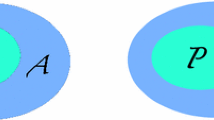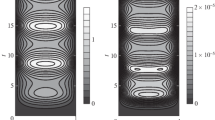Abstract
Approximating numerically the solutions of a reaction–diffusion system in an efficient manner requires the application of implicit methods, since the Courant–Friedrichs–Lewy condition on explicit methods imposes a time step of the order of the square of the space step. In this article, we review two types of strategies which are expected to yield reasonably precise solutions within a reasonable computing time. The first examines methods for solving the linear step necessary in any resolution procedure; estimates of CPU time in terms of the error are given in the non preconditioned and in the preconditioned case – provided that it is possible to define an efficient preconditioner. The second strategy is based on splitting, with or without extrapolation. The respective faults and qualities of both strategies are examined; they lead to a list of difficult analytical and numerical problems with possible hints as to their solution.
Similar content being viewed by others
References
G. Akrivis, M. Crouzeix and C. Makridakis, Implicit-explicit multistep finite element methods for nonlinear parabolic problems, Math. Comp. 67(222) (1998) 457–477.
R. Barrett, M. Berry, T.F. Chan et al., Templates for the solution of linear systems: building blocks for iterative methods, Society for Industrial and Applied Mathematics (SIAM, Philadelphia, PA, 1994), http://www.netlib.org/templates/templates.ps.
F.A. Bornemann, An adaptive multilevel approach to parabolic equations. II. Variable-order time discretization based on a multiplicative error correction, Impact Comput. Sci. Engrg. 3(2) (1991) 93–122.
F.A. Bornemann, An adaptive multilevel approach to parabolic equations. III. 2D error estimation and multilevel preconditioning, Impact Comput. Sci. Engrg. 4(1) (1992) 1–45.
P.N. Brown and C.S.Woodward, Preconditioning strategies for fully implicit radiation diffusion with material-energy transfer. Technical Report UCRL-JC-139087, Lawrence Livermore National Laboratory (2000).
J.C. Butcher and M.T. Diamantakis, DESIRE: diagonally extended singly implicit Runge-Kutta effective order methods, Numer. Algorithms 17(1-2) (1998) 121–145.
J.C. Butcher and Z. Jackiewicz, Implementation of diagonally implicit multistage integration methods for ordinary differential equations, SIAM J. Numer. Anal. 34(6) (1997) 2119–2141.
J.C. Butcher and Z. Jackiewicz, Construction of high order diagonally implicit multistage integration methods for ordinary differential equations, Appl. Numer. Math. 27(1) (1998) 1–12.
A.J. Chorin, M.F. McCracken, T.J.R. Hughes and J.E. Marsden, Product formulas and numerical algorithms, Comm. Pure Appl. Math. 31(2) (1978) 205–256.
S. Descombes, Convergence of a splitting method of high order for reaction-diffusion system, Math. Comp. (2001) to appear.
S. Descombes and B.O. Dia, An operator-theoretic proof of an estimate on the transfer operator, J. Funct. Anal. 165(2) (1999) 240–257.
S. Descombes and M. Ribot, Convergence of the peaceman-rachford approximation for reaction-diffusion systems, Technical Report, MAPLY, Université Claude Bernard-Lyon 1, France (2001) in preparation.
S. Descombes and M. Schatzman, Directions alternées d'ordre élevé en réaction-diffusion, C. R. Acad. Sci. Paris Sér. I Math. 321(11) (1995) 1521–1524.
S. Descombes and M. Schatzman, Strang's formula for holomorphic semi-groups, J. Math. Pures Appl. (2001) to appear; http://www.umpa.ens-lyon.fr/sdescomb/holom.ps.
B.O. Dia, Méthodes de directions alternées d'ordre élevé en temps, Ph.D. thesis, Université Claude Bernard Lyon 1 (1996).
B.O. Dia and M. Schatzman, Estimations sur la formule de Strang, C. R. Acad. Sci. Paris Sér. I Math. 320(7) (1995) 775–779.
B.O. Dia and M. Schatzman, On the order of extrapolation of integration formulae. Technical Report, Equipe d'Analyse Numérique Lyon Saint-Etienne, Université Claude Bernard Lyon 1 (1995). 268
B.O. Dia and M. Schatzman, Commutateurs de certains semi-groupes holomorphes et applications aux directions alternées, RAIRO Modél. Math. Anal. Numér. 30(3) (1996) 343–383.
B.O. Dia and M. Schatzman, An estimate of the Kac transfer operator, J. Funct. Anal. 145(1) (1997) 108–135.
A. Doumeki, T. Ichinose and H. Tamura, Error bounds on exponential product formulas for Schrödinger operators, J. Math. Soc. Japan 50(2) (1998) 359–377.
S. Gaiffe, R. Glowinski and R. Masson, Méthodes de décomposition de domaine et d'opérateur pour les problèmes paraboliques, C. R. Acad. Sci. Paris Sér. I Math. 331(9) (2000) 739–744.
A. Gerisch and J.G. Verwer, Operator splitting and approximate factorization for taxis-diffusionreaction models, Technical Report, CWI, Amsterdam (2000), ftp://ftp.cwi.nl/pub/ reports/MAS/MAS-R0026.ps.Z.
T. Ichinose and S. Takanobu, Estimate of the difference between the Kac operator and the Schrödinger semigroup, Comm. Math. Phys. 186(1) (1997) 167–197.
T. Ichinose and H. Tamura, Error estimate in operator norm for Trotter-Kato product formula, Integral Equations Operator Theory 27(2) (1997) 195–207.
T. Ichinose and H. Tamura, Error bound in trace norm for Trotter-Kato product formula of Gibbs semigroups, Asymptot. Anal. 17(4) (1998) 239–266.
T. Ichinose and H. Tamura, Error estimate in operator norm of exponential product formulas for propagators of parabolic evolution equations, Osaka J. Math. 35(4) (1998) 751–770.
T. Jahnke and C. Lubich, Error bounds for exponential operator splittings, BIT 40(4) (2000) 735–744.
R. Kozlov and B. Owren, Order reduction in operator splitting methods, Technical Report Numerics, 6/1999, The Norwegian University of Science and Technology, Trondheim (1999), http://www.math.ntnu.no/num/synode/papers/ps/kozlov99ori.ps.
J. Lang, Two-dimensional fully adaptive solutions of reaction-diffusion equations, in: Seventh Conf.on the Numerical Treatment of Differential Equations, Halle, 1994, Appl. Numer. Math. 18(1-3) (1995) 223–240.
J. Lang, Adaptive FEM for reaction-diffusion equations, in: Proc. of the Internat. Centre for Mathematical Sciences Conf. on Grid Adaptation in Computational PDEs: Theory and Applications, Edinburgh, 1996, Vol. 26 (1998) pp. 105–116.
J. Lang, Adaptive Multilevel Solution of Nonlinear Parabolic PDE Systems, Theory, Algorithm, and Applications (Springer, Berlin, 2001).
J. Lang and A. Walter, A finite element method adaptive in space and time for nonlinear reaction-diffusion systems, Impact Comput. Sci. Engrg. 4(4) (1992) 269–314
J. Lang and A. Walter, An adaptive Rothe method for nonlinear reaction-diffusion systems, in: Sixth Conf. on the Numerical Treatment of Differential Equations, Halle, 1992, Appl. Numer.Math. 13(1-3) (1993) 135–146.
D. Lanser and J.G. Verwer, Analysis of operator splitting for advection-diffusion-reaction problems from air pollution modelling, in: Numerical Methods for Differential Equations, Coimbra, 1998, J. Comput. Appl. Math. 111(1/2) (1999) 201–216.
C. Lubich and A. Ostermann, Runge-Kutta approximation of quasi-linear parabolic equations, Math. Comp. 64(210) (1995) 601–627.
C. Lubich and A. Ostermann, Runge-Kutta time discretization of reaction-diffusion and Navier-Stokes equations: Nonsmooth-data error estimates and applications to long-time behaviour, Special issue celebrating the centenary of Runge-Kutta methods, Appl. Numer. Math. 22(1-3) (1996) 279–292.
Y. Maday, A.T. Patera and E.M. R¸nquist, An operator-integration-factor splitting method for timedependent problems: Application to incompressible fluid flow, J. Sci. Comput. 5 (1990) 263–292.
G.I. Marchuk, Methods of Numerical Mathematics, 2nd ed. (Springer, New York, 1982) (translated from the Russian by A.A. Brown).
G.I. Marchuk, Metody Rasshchepleniya i Peremennykh Napravlenii (Akad. Nauk SSSR Otdel Vychisl.Mat., Moscow, 1986).
G.I. Marchuk, Metody Rasshchepleniya (Nauka, Moscow, 1988).
G.I. Marchuk, Splitting and alternating direction methods, in: Handbook of Numerical Analysis, Vol. I (North-Holland, Amsterdam, 1990) pp. 197–462.
J.D. Murray, Mathematical Biology, 2nd ed. (Springer, Berlin, 1993).
D.W. Peaceman and H.H. Rachford, Jr., The numerical solution of parabolic and elliptic differential equations, J. Soc. Indust. Appl. Math. 3 (1955) 28–41.
Y. Saad, Iterative solution of linear systems in the 20th century, Technical Report umsi-99-152, Department of Computer Science, University of Minnesota (1999), ftp://ftp.cs.umn.edu/ dept/users/saad/reports/FILES/umsi-99-152.ps.gz.
M. Schatzman, Stability of the Peaceman-Rachford approximation, J. Funct. Anal. 162(1) (1999) 219–255.
Q. Sheng, Solving linear partial differential equations by exponential splitting, IMA J. Numer. Anal. 9 (1989) 199–212.
B. Sportisse, Contributions à la modélisation des écoulements réactifs: Réduction des modèles de cinétique chimique et simulation de la pollution atmosphérique, Ph.D. thesis, Ecole Polytechnique (1999).
B. Sportisse, An analysis of operator splitting techniques in the stiff case, J. Comput. Phys. 161(1) (2000) 140–168.
B. Sportisse and J. Verwer, A note on operator splitting in the stiff linear case, Technical Report MASR9830, CWI, Amsterdam (1998), ftp://ftp.cwi.nl/pu/gollum/MAS-R9330.ps.Z.
G. Strang, On the construction and comparison of difference schemes, SIAMJ. Numer. Anal. 5 (1968) 506–517.
S. Takanobu, On the error estimate of the integral kernel for the Trotter product formula for Schrödinger operators, Ann. Probab. 25(4) (1997) 1895–1952.
S. Takanobu, On the trace norm estimate of the Trotter product formula for Schrödinger operators, Osaka J. Math. 35(3) (1998) 659–682.
J.G. Verwer, E.J. Spee, J.G. Blom and W. Hundsdorfer, A second-order Rosenbrock method applied to photochemical dispersion problems, SIAM J. Sci. Comput. 20(4) (1999) 1456–1480 (electronic).
Author information
Authors and Affiliations
Rights and permissions
About this article
Cite this article
Schatzman, M. Numerical Integration of Reaction–Diffusion Systems. Numerical Algorithms 31, 247–269 (2002). https://doi.org/10.1023/A:1021199103644
Issue Date:
DOI: https://doi.org/10.1023/A:1021199103644




